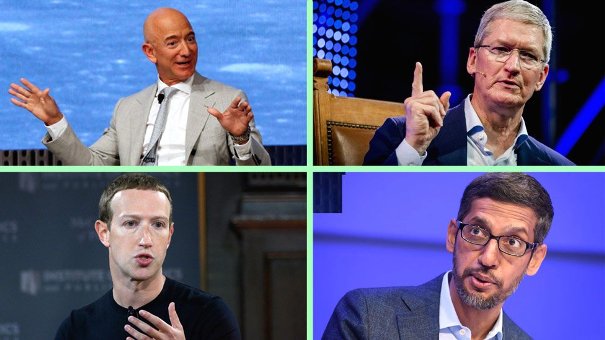
Less Engagement, Disengagement and Other Ethical Ways
ALSO READ: An Approach to Deal with Technology Dominance (Part 2)
‘Technology dominance,’ these two words we hear quite often these days. From the last few years, Big Tech, Big Four, GAFA (Google, Amazon, Facebook, Apple), Tech Giants, Big Five kind of terms have become a part of our strategic discussions. Today, any deliberation on the future, economy and national security cannot be called complete without mentioning the patterns of growing tech dominance.
Computer technology is indeed one of the most dominant technologies from the last three to four decades. It started with the personal computers (PC) then came the era of the Internet, then smart phones, then smart devices and now we are talking about moving toward a new technological revolution driven by Artificial Intelligence (AI). But, at the same time, matters of concern are the shift in the purpose of digital technology from problem-solver to problem-creator to problem-accelerator to toolkit distributor, and its growing capability to not just impact overall social behavior and psychology but of creating anarchy, violence, and riots on the streets, within a matter of few minutes. The patterns of some recent events in different parts of the world suggest that now these platforms are becoming eager to challenge the idea of democracy, the idea of government and the idea of the nation itself.
Different Dimensions of Technology Dominance
A majority of the discussions about the technology dominance in India revolved around the Market and Data but there are some other lesser discussed dimensions as well, such as dominance in the real world, the acquisition/exploitation of natural resources – land, energy and water – that is going on a massive scale. There are close to 4.66 billion Internet users (roughly 60% of the world’s population), an average Internet user spends more than 6 hours a day online and produces approx 2.5 quintillion bytes of data (1 quintillion is equal to 1 exabyte, which is one preceded by 18 zeros). Every day, these platforms process billions of searches, millions of images, videos, billions of emails, video streaming, Twitter feeds, Facebook/ Linkedin/ Instagrams posts, text messages/chats, Gifs/Emojis, navigation data and the bulk of data that is generated from the smart things/devices, too. The data warehouses and factories where all this data is stored and processed every second requires gigantic infrastructure, massive systems for data storage, several processors and millions of miles of fiber-optic lines, everything which they cover under the smart term ‘cloud’ and these clouds on earth consume electrical power and generate heat that no other industrial enterprises have ever generated in human history, and then they consume billions of gallons of water to cool off as well. This is the real-world dominance of these Big Tech companies about which we do not find any climate expert raising concerns. In fact, in some cases, they are the top sponsors of these teenager flag bearers of climate change.
ALSO READ: PANDEMIC: Security Concerns Over Big Tech, Biotech and Big Pharma Loop
Apart from that, something more serious is going on under the sea as well. The 750,000 miles of submarine cables (total 406) enough to go around the earth 30 times, that connect the Internet worldwide – are the backbone of the Internet infrastructure. Today, the US tech giants such as Google, Facebook, Amazon and Microsoft, own or lease more than half of the global undersea cables. Google owns some 63,065 miles, Facebook owns 57,079 miles, Amazon owns approx 18,987 miles and Microsoft owns some 41,04 miles of undersea cables. And, with each passing year, their acquisition of undersea Internet infrastructure is growing.
Now the testing of shipping container-sized undersea data centres has started as well. In 2014, Microsoft launched a research project called ‘Natick’ to test this infrastructure and, as of 2020, they had completed the project and claimed that those servers under the water were more reliable than those on the land. The results of their project signalled that we will see a new dimension of undersea autonomy shortly. And the logic for such an experiment was a one-liner – “50% of us live near the coast. Why doesn’t our Data?”
Technology dominance is often facilitated by legislations too. In 2018, the US Senate enacted an act called CLOUD (clarifying lawful overseas use of data). The CLOUD Act allows US federal law enforcement agencies to compel U.S.-based technology companies or content providers to provide access to electronic data stored on their servers regardless of whether they are in the U.S. or on foreign soil. And it also says that if the foreign law enforcement agency (like that of India, where these products have complete dominance in the market) needs access to the electronic content stored in these data servers then they need to undergo an ‘executive agreement’ with the US government. The Act has the support of the whole Big Tech consortium (Google, Microsoft, Apple, Amazon and Facebook). Such moves give an extra edge to this ever-growing physical and virtual dominance. These are some of the interesting and least discussed dimensions of technology dominance, which have the potential to establish this idea as an everlasting reality of our time.
ALSO READ: Information Warfare : Curbs on Big Tech Necessary
Other than these, in terms of Market and Data (the most talked about dimensions), the situation is already bleak. If we talk about the Market, the journey of these U.S. tech giants in India started in 2004, with an entirely different set of promises than what they tout today. They came with the offers like office, search, music, emails, shopping and chats, some very routine tasks of the people. Except for Microsoft, which came earlier, somewhere in the 1990s, all other U.S. tech giants entered India, post-2004 and then, from 2004 to 2014, one can say that they got a whole decade of privileged access in India. The legacy of that unrestricted phase culminated into the current market dominance that we see today. As of May 2020, with 99.29 per cent, Google had a clear monopoly on the mobile search engine market in India. Google-owned YouTube now has over 448 million monthly active users in India and the Google-owned Android held a share of 95.23 percent of the mobile operating system market in India. Facebook has over 400 million users and 85 per cent market share in India, which is more than its home country USA. Amazon has over 100 million users and with 17.5 million active users, Twitter has the third largest user base in India, next after the USA and Japan. The data speaks that things are now beyond the simple profit/loss calculations.
Silicon Valley – Vision, Recommendations and Propaganda
In parallel to these mounting dimensions, the leading employers and investors of Silicon Valley and their friends and family members, all have some big plans for the future of humanity too. Often they can be seen talking about things like some ‘X’ pandemic or disaster already on our way and how we need to radically transform our lives to accommodate and adapt to that future. But interestingly, these technology prophets who are making such a prognosis, have their silent investments in the Biotech and Big Pharma companies too. In most cases, their life partners are leading such initiatives.
At regular intervals one will find some interview by Elon Musk, talking about things like AI is an ‘existential threat to humanity, raising concern on Google’s Deep Mind lab and claiming how scary and ‘weird’ the future is. And Musk is one of those who are not merely talking but preparing the solutions too, for example, the Neuralink kind of projects, that are about implantable brain–machine interfaces that Musk called a ‘Fitbit in your skull.’
There is a whole lobby of propagandists that exists in Silicon Valley. A massive propagation of ideas like the mindset of abundance, shifting humanity from ‘haves’ and ‘have-nots’ stage to ‘haves’ and ‘super haves,’ Universal Basic Income, Homo Deus, Cyborg, etc., is going on with different creative improvisations. In a nutshell, from Market and Data, things are now going toward body, mind and future.
Google Marxism
The idea that Silicon Valley represents the American ‘spirit of enterprise’ is not convincing anymore. The white hair technocrats and visionaries of the USA (who led the US economy in the Reagan era), call the Silicon Valley brigade ‘Neo Marxist.’ They refer to their approach as ‘Google Marxism’ and they have valid arguments for that, too. In his book “Life after Google”, George Gilder, one of the most quoted authors of US President Ronald Reagan, writes “The neo-Marxism of today’s Silicon Valley titans repeats the error of the old Marxists in its belief that today’s technology—not steam and electricity, but silicon microchips, artificial intelligence, machine learning, cloud computing, algorithmic biology and robotics—is the definitive human achievement. The algorithmic eschaton renders obsolete not only human labor but the human mind as well.” When the powerful technology tycoons, with immense control of human life in their hands, try to push the obsolete ideas on their users, the concerns are only inevitable.

















